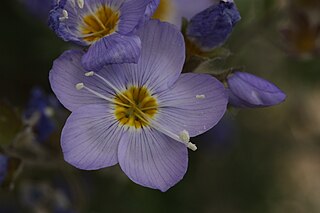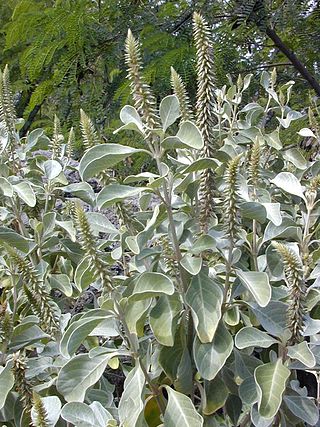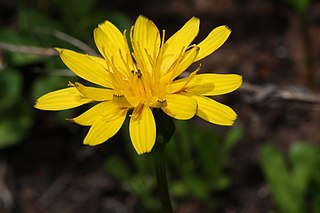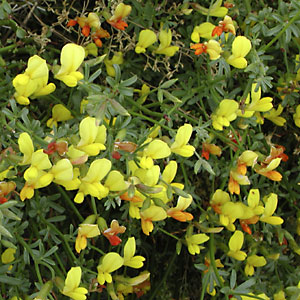
Penstemon, the beardtongues, is a large genus of roughly 280 species of flowering plants native mostly to the Nearctic, but with a few species also found in the North American portion of the Neotropics. It is the largest genus of flowering plants endemic to North America. As well as being the scientific name, penstemon is also widely used as a common name for all Penstemon species alongside beardtongues.

Polemonium boreale, the northern Jacob's-ladder or boreal Jacobs-ladder, is a plant native to the most of the high arctic. In Greenland it is found only in a small area on the east coast. It is not very common.

Triadenum, known as marsh St. John's worts, is a small genus of flowering plants in the family Hypericaceae. The genus is characterized by opposite, blunt-tipped leaves and pink flowers with 9 stamens. They are distributed in North America and eastern Asia.

Polemonium acutiflorum, known as tall Jacob's-ladder, is a flowering plant in the family Polemoniaceae. It is native to western Canada and Alaska.

Microseris is a genus of plants in the tribe Cichorieae within the family Asteraceae, plants that often called composites. They are native to North America, South America, Australia, and New Zealand.

Achyranthes is a genus of medicinal and ornamental plants in the amaranth family, Amaranthaceae. Chaff flower is a common name for plants in this genus.

Orthocarpus, or owl's-clover, is a genus of flowering plants in the family Orobanchaceae (broomrapes). They are native to North America. A number of species formerly included in Orthocarpus have been transferred to the genus Castilleja, which includes the plants commonly known as Indian paintbrush. Plants of the genus are generally less than 30 centimetres (1 ft) in height.

Orbexilum, commonly called leather-root, is a genus of flowering plants in the legume family (Fabaceae). They are native to North America, where they are found in the United States and Mexico, south to Chiapas.

Acmispon cytisoides, synonyms Lotus benthamii and Syrmatium cytisoides, is a species of legume native to California. It is known by the common names Bentham's broom and Bentham's deerweed. It is endemic to central California, where it occurs along the Central Coast and into the coastal mountain ranges. It grows in oceanside habitat and inland on slopes and in canyons. It is a mat-forming or spreading perennial herb lined with leaves each made up of a few oval leaflike leaflets up to 12 mm long. The inflorescence bears up to 10 dull pinkish dark-veined flowers, each just under 1 cm long.
Acmispon junceus, synonyms Lotus junceus and Syrmatium junceum, is a species of legume native to California. It is known by the common names rush broom and rush deervetch. It is endemic to California, where it is known from the northern and central coast and the coastal mountain ranges. It can be found from beaches inland to serpentine slopes and chaparral. It is a hairy, prostrate or spreading perennial herb lined with leaves each made up of small oval leaflets. The inflorescence bears up 8 yellow pealike flowers each up to about a centimeter long. The fruit is a small beaked legume pod.

Nothocalais is a genus of North American flowering plants in the tribe Cichorieae within the family Asteraceae. There are known generally as false dandelions or false agoseris.

Polemonium californicum is a species of flowering plant in the phlox family known by the common names moving polemonium, low Jacob's-ladder, and California Jacob's ladder. It is native to the northwestern United States, where it grows in shady and moist habitat, such as mountain woodlands. It is a hairy, glandular rhizomatous perennial herb forming clumps of several decumbent to erect stems 30 to 50 centimeters in maximum height. The leaves are up to 20 centimeters long and are compound, made up of several pairs of oval to lance-shaped leaflets. The leaflet at the tip of the leaf is often fused to the pair behind it. The inflorescence is a crowded cluster of bell-shaped flowers each up to 1.5 centimeters wide. The flower is blue or purple with a yellow center and a whitish tubular throat. The fruit is a capsule.

Polemonium occidentale is a species of flowering plant in the phlox family known by the common names western polemonium and western Jacob's-ladder. There are two subspecies. The common ssp. occidentale is native to western North America from British Columbia to Colorado to California, where it can be found in moist areas of many habitat types, including meadows and woodlands. There is also a rare subspecies, ssp. lacustre, which is known only from a total of three counties in Minnesota and Wisconsin, and is found only in white cedar swamp habitat there.

Lumnitzera is an Indo-West Pacific mangrove genus in the family Combretaceae. An English common name is black mangrove. Lumnitzera, named after the German botanist, Stephan Lumnitzer (1750-1806), occurs in mangroves from East Africa to the Western Pacific, and northern Australia.

Polemonium vanbruntiae is a species of flowering plant in the phlox family Polemoniaceae. It is known by the common names Appalachian Jacob's ladder, bog Jacob's-ladder, and Vanbrunt's polemonium. It is native to eastern Canada and the northeastern United States.

Acmispon rigidus, synonyms Lotus rigidus and Ottleya rigida, is a flowering plant in the pea family (Fabaceae), native to the southwestern United States and northwestern Mexico. It is known as shrubby deervetch or desert rock-pea. It is found in the Mojave Desert and Sonoran Desert.

Polemonium elegans, the elegant Jacob's-ladder, is a rare species of flowering plant in the phlox family found in the United States.

Polemonium foliosissimum, the towering Jacob's-ladder, is a rare species of flowering plant in the phlox family Polemoniaceae, native to the western United States; Arizona, Colorado, Idaho, Nevada, New Mexico, Utah and Wyoming. As its synonym Polemonium archibaldiae it has gained the Royal Horticultural Society's Award of Garden Merit.

Polemonium pauciflorum, the fewflower Jacob's-ladder, is a rare species of flowering plant in the phlox family found in the United States and Mexico.




















